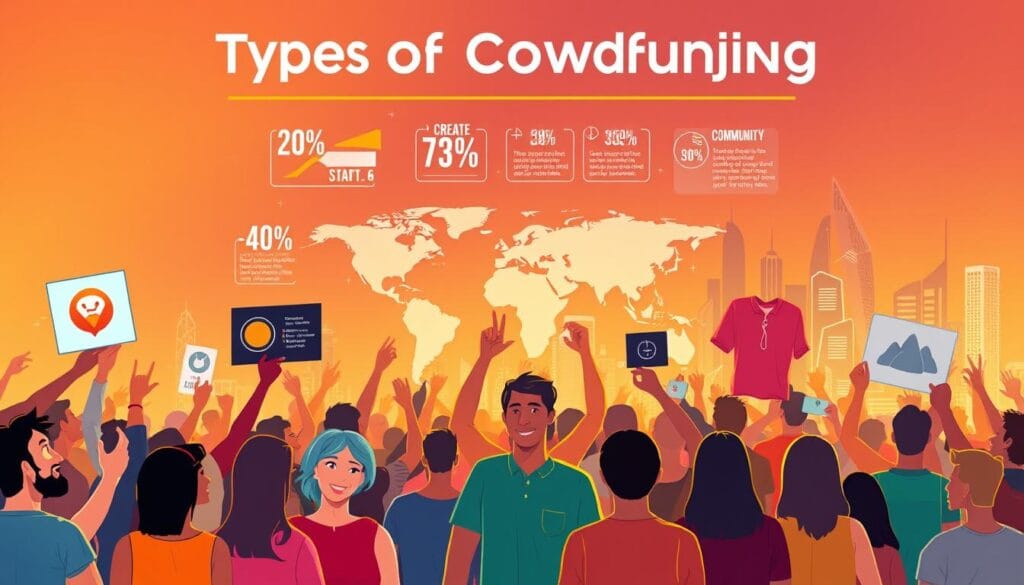The global crowdfunding market reached a staggering $1.4 billion in 2023 and is projected to double by 2030. This explosive growth highlights the increasing reliance on alternative funding methods for businesses. Platforms like Kickstarter have already hosted over 592,000 projects, showcasing their dominance in this space.
For entrepreneurs, choosing the right platform is critical. Factors like fees, investor reach, and sector specialization play a significant role in success. Traditional funding methods often come with limitations, but crowdfunding offers a democratized approach to raising capital.
Looking ahead to 2025, emerging features on these platforms will further revolutionize startup financing. From enhanced analytics to niche market targeting, the future of funding is bright. Understanding these trends can help businesses make informed decisions and secure the resources they need to thrive.
Key Takeaways
- The global crowdfunding market is valued at $1.4 billion and growing rapidly.
- Kickstarter has funded over 592,000 projects, setting a benchmark for success.
- Platform selection criteria include fees, investor reach, and sector focus.
- Emerging features in 2025 will transform startup financing.
- Crowdfunding provides a more accessible alternative to traditional funding methods.
Introduction to Crowdfunding for Startups

Modern crowdfunding has reshaped how startups secure capital, with $1.03 billion generated in 2024. This funding method has become a cornerstone of the startup ecosystem, offering a democratic alternative to traditional financing. Unlike the past, where only accredited investors could participate, crowdfunding now invites the public to contribute, broadening access to funds.
The average campaign raises around $8,000, making it an accessible option for early-stage ventures. Beyond funding, crowdfunding serves as a tool for market validation. Entrepreneurs can gauge interest in their products or services before full-scale production, reducing risks.
One notable example is Shopify’s integration with the Crowdfunder app, which streamlined campaign management for small businesses. This collaboration highlights how technology enhances crowdfunding’s efficiency and reach. For those exploring alternative funding methods, micro-investing platforms also offer valuable opportunities.
As crowdfunding evolves, its dual purpose—raising capital and validating ideas—makes it indispensable for startups. With its growing economic impact, this method continues to empower entrepreneurs and reshape the funding landscape.
What is Crowdfunding?

Crowdfunding has emerged as a game-changer in the financial world, offering startups a unique way to raise funds. Unlike traditional methods like bank loans or venture capital, it allows businesses to tap into a larger pool of investors. This approach is regulated under the JOBS Act Title III, ensuring transparency and security for all parties involved.
Traditional financing often involves lengthy processes and strict eligibility criteria. In contrast, crowdfunding simplifies access to money by connecting entrepreneurs directly with potential backers. This model is overseen by FINRA, which enforces investor protections like the 48-hour cancellation window.
There are four main types of crowdfunding transactions: rewards, equity, debt, and donations. Each serves a specific purpose, from pre-selling products to offering shares in a business. For example, blockchain crowdfunding is gaining traction as a secure and transparent option.
Platforms like Stripe Atlas have further streamlined the process by assisting with global startup incorporation. However, businesses should be aware of fee structures, which typically range from 3% to 10%, plus payment processing costs. These fees vary based on the service provided and the platform chosen.
“Crowdfunding empowers entrepreneurs to turn their ideas into reality by leveraging the collective support of investors.”
In summary, crowdfunding is a versatile and accessible method for raising capital. It not only provides financial resources but also validates business ideas and builds a community of supporters. As the landscape evolves, it continues to shape the future of startup financing.
Benefits of Crowdfunding for Startups

Startups today have a powerful tool to secure funding and validate their ideas. This method offers a range of advantages, from financial support to building a loyal community. By leveraging collective support, businesses can achieve their goals more efficiently.
Access to Capital
One of the most significant benefits is the ability to raise funds beyond traditional lenders. StartEngine, for example, has facilitated over $500 million in funding. This democratized approach allows entrepreneurs to tap into a broader pool of investors, ensuring greater financial flexibility.
Market Validation
Another key advantage is the ability to test product-market fit. Studies show that 72% of successful campaigns achieve this validation. This reduces risks and ensures that businesses focus on ideas with proven demand. It’s a win-win for both entrepreneurs and investors.
Community Building
Beyond funding, this method fosters a loyal community of supporters. Platforms offer analytics tools to engage backers effectively. For instance, BodyBoss leveraged Indiegogo InDemand to maintain momentum post-campaign, showcasing the power of sustained engagement.
“The collective support of investors not only fuels growth but also builds a foundation for long-term success.”
For those exploring alternative funding methods, micro-investing platforms also provide valuable opportunities. By combining these strategies, startups can maximize their potential and achieve sustainable growth.
Types of Crowdfunding

Entrepreneurs have multiple funding options to choose from, each tailored to specific business needs. Understanding the different types crowdfunding can help businesses select the best approach for their goals. These methods vary in structure, benefits, and requirements, making it essential to evaluate each carefully.
Reward-Based Crowdfunding
This method allows businesses to offer products or services in exchange for financial support. Platforms like Kickstarter charge a 5% platform fee, while Indiegogo offers flexible funding options. Kickstarter’s all-or-nothing model ensures campaigns only receive funds if they meet their goals, whereas Indiegogo allows partial funding.
Equity-Based Crowdfunding
In this approach, investors receive shares in the company in exchange for their contributions. The SEC’s Regulation CF limits equity campaigns to a $5 million cap. This method is ideal for businesses looking to raise significant capital while sharing ownership with backers.
Debt-Based Crowdfunding
Also known as peer-to-peer lending, this method involves borrowing money that must be repaid with interest. LendingClub’s rates often contrast with traditional SBA loans, offering competitive terms for borrowers. Honeycomb Credit provides a unique twist, offering a 6-14% ROI for local business lending.
Donation-Based Crowdfunding
This method is typically used for charitable causes or community projects. GoFundMe, for example, charges a 2.9% payment fee, making it accessible for personal and nonprofit campaigns. It’s a popular choice for those seeking support without offering financial returns.
“Choosing the right funding method depends on your business goals, target audience, and financial needs.”
Each type crowdfunding has its advantages and challenges. By understanding these options, entrepreneurs can make informed decisions that align with their vision and resources.
Top Crowdfunding Platforms for Startups in 2025

In 2025, selecting the right funding solution is critical for businesses aiming to scale efficiently. The landscape of alternative financing continues to evolve, offering diverse options tailored to different needs. Here’s a closer look at the best crowdfunding platforms that are shaping the future of startup funding.
Kickstarter
Kickstarter remains a leader in the space, known for its all-or-nothing funding model. Projects like Rockwell Razors have successfully leveraged its platform, which charges a 5% fee plus 3-5% for payment processing. This model ensures campaigns only receive funds if they meet their goals, reducing risks for backers.
Indiegogo
Indiegogo offers flexibility with its funding options, including the InDemand feature that allows campaigns to continue raising money post-launch. This makes it an attractive choice for businesses seeking sustained momentum. Its fee structure is competitive, making it accessible for early-stage ventures.
Fundable
Fundable specializes in equity campaigns, charging a $179 monthly fee. It’s particularly popular among B2B SaaS companies, providing a streamlined process for raising capital. Its focus on equity makes it a go-to for businesses looking to share ownership with investors.
StartEngine
StartEngine has raised over $500 million, making it a powerhouse in the equity crowdfunding space. Its unique feature includes secondary market trading via Reg A+ offerings, providing liquidity for backers. This platform is ideal for businesses aiming for significant capital infusion.
Wefunder
Wefunder stands out with its low minimum investment of $100, making it accessible to a broader audience. It also integrates with STRATA Trust IRA, allowing retirement investors to participate. This innovative approach broadens the pool of potential backers, enhancing funding opportunities.
“Choosing the right platform depends on your business goals, target audience, and financial needs.”
Each of these crowdfunding platforms offers unique advantages, from flexible funding models to equity-based solutions. By understanding their features and fees, businesses can make informed decisions that align with their growth strategies.
How to Choose the Right Crowdfunding Platform

Selecting the ideal funding solution requires careful consideration of various factors. From understanding your financial goals to evaluating costs, each step plays a crucial role in ensuring success. This section breaks down the key elements to help you make an informed decision.
Understanding Your Funding Needs
Before selecting a platform, identify your financial objectives. Are you looking to raise capital for product development or expand your business? Different platforms cater to specific needs, such as equity-based models for long-term growth or reward-based options for product launches.
For example, GoFundMe is ideal for personal or nonprofit campaigns, while Wefunder focuses on tech ventures. Knowing your goals ensures you choose a platform aligned with your vision.
Evaluating Platform Fees
Costs vary significantly across platforms. Fundrise charges annual fees of 0.85-1.85%, while Crowdcube takes a 7% success fee. These fees can impact your overall budget, so it’s essential to compare them carefully.
Additional expenses, such as campaign preparation costs (legal, marketing, prototype development), should also be factored in. Understanding the full financial picture helps you avoid unexpected surprises.
Assessing Platform Reach and Community
The success of your campaigns often depends on the platform’s reach and community. Kickstarter attracts creative individuals, while StartEngine targets venture capitalists. Matching your project with the right audience increases your chances of success.
For sector-specific recommendations, consider Wefunder for tech ventures or Kickstarter for retail projects. Each platform offers unique advantages tailored to different industries.
“Choosing the right funding solution depends on your goals, audience, and financial needs.”
By carefully evaluating these factors, you can select a platform that maximizes your potential and aligns with your objectives. Whether you’re launching a new product or scaling your business, the right choice can make all the difference.
Success Stories: Startups That Thrived Through Crowdfunding

Many businesses have turned to alternative funding methods to achieve remarkable milestones. These success stories highlight how innovative ideas, combined with effective strategies, can lead to significant growth.
LastObject, known for its reusable cotton swabs, raised an impressive $1.7 million on Kickstarter. This achievement underscores the power of addressing environmental concerns with practical solutions. Their campaign resonated with investors who valued sustainability and innovation.
SaniKind, a UV sanitizer brand, attracted 3,194 backers in just 30 days. Their ability to meet a growing demand for hygiene products during a critical time played a key role in their success. This case study demonstrates the importance of timing and relevance in campaigns.
BodyBoss, a fitness gear company, transitioned from Kickstarter to Shopify, showcasing how businesses can scale effectively. Their post-campaign strategy included leveraging analytics and maintaining engagement with their community. This approach ensured sustained growth beyond the initial funding phase.
Common factors among these startups include pre-launch email lists and high-quality videos. These elements help build anticipation and trust, which are crucial for attracting backers. Additionally, clear communication and transparency foster long-term relationships with supporters.
For more inspiring stories, explore top crowdfunding success stories. These examples highlight the transformative potential of alternative funding methods.
“Effective campaigns combine innovation, timing, and community engagement to achieve lasting success.”
By analyzing these success stories, entrepreneurs can gain valuable insights into what drives impactful campaigns. Whether it’s addressing a market need or building a loyal community, the right strategies can turn ideas into thriving businesses.
Common Challenges in Crowdfunding and How to Overcome Them
Navigating the complexities of raising funds through alternative methods can present significant hurdles for businesses. From missed funding targets to regulatory compliance, these challenges require strategic planning and execution. Understanding these obstacles is the first step toward overcoming them.
Reaching Funding Goals
One of the most common challenges is failing to meet financial targets. Kickstarter, for instance, reports a 35% failure rate for campaigns. Misjudging marketing budgets is a key factor, with 38% of failed initiatives underestimating these costs.
To avoid this, businesses should research similar successful campaigns to set realistic goals. Additionally, using storytelling to convey the value proposition can help attract more investors.
Managing Backer Expectations
Another hurdle is ensuring backers remain satisfied throughout the process. Transparency about the company’s mission and milestones is crucial. Overpromising can lead to dissatisfaction, so it’s essential to set clear expectations from the start.
For more insights on managing expectations, explore this detailed guide.
Navigating Legal and Regulatory Requirements
Compliance with legal standards is another critical aspect. Equity-based campaigns, for example, require SEC Form C disclosures. These regulations ensure transparency but can be complex to navigate.
Partnering with third-party logistics providers can help manage fulfillment costs, which often exceed budgets by 23%. Escrow solutions are also recommended for all-or-nothing funding models to ensure financial security.
“Effective planning and transparency are key to overcoming the hurdles of alternative funding methods.”
By addressing these challenges head-on, businesses can increase their chances of success. Whether it’s setting realistic goals or ensuring legal compliance, the right strategies make all the difference.
Future Trends in Crowdfunding for Startups
The landscape of startup financing is evolving rapidly, driven by technological advancements and innovative strategies. As we look ahead, several key trends are set to redefine how businesses raise capital and engage with investors.
AI-powered tools are transforming campaign optimization. Predictive algorithms will match projects with the right backers, increasing success rates. These tools analyze data to identify patterns, ensuring campaigns reach their full potential.
Blockchain technology is also making waves. It enables transparent and secure fractional equity management, allowing investors to track their stakes in real-time. This innovation builds trust and simplifies complex transactions.
Hybrid models combining equity and rewards are gaining traction. These approaches offer flexibility, appealing to a broader range of backers. For example, a startup might offer shares alongside early access to products, creating a win-win scenario.
Virtual reality is another emerging trend. VR pitch decks provide immersive experiences, helping entrepreneurs showcase their ideas more effectively. This technology is expected to see widespread adoption in the coming years.
Regulatory changes are also on the horizon. Global harmonization of laws will simplify cross-border funding, making it easier for startups to attract international investors. This shift will foster growth and innovation on a global scale.
“The integration of AI, blockchain, and VR is reshaping the funding landscape, offering unprecedented opportunities for businesses and backers alike.”
For those interested in exploring automated financial strategies, automated portfolio management provides valuable insights. These advancements are not just trends—they are the future of startup financing.
Conclusion
As 2025 approaches, innovative funding strategies are reshaping how businesses secure resources. Selecting the right crowdfunding platforms involves evaluating criteria like fees, reach, and sector focus. These platforms are now integral to broader capital stack strategies, offering flexibility alongside traditional methods like Shopify Capital’s revenue-based financing.
Global incorporation tools like Stripe Atlas further simplify cross-border funding, enabling startups to attract international investors. Emerging features, such as AI-driven analytics and blockchain transparency, are set to revolutionize the landscape by 2025.
For a successful campaign, ensure clear goals, a compelling narrative, and robust preparation. Understanding these elements can help businesses maximize their funding potential and achieve sustainable growth. For more insights, explore this detailed guide.

